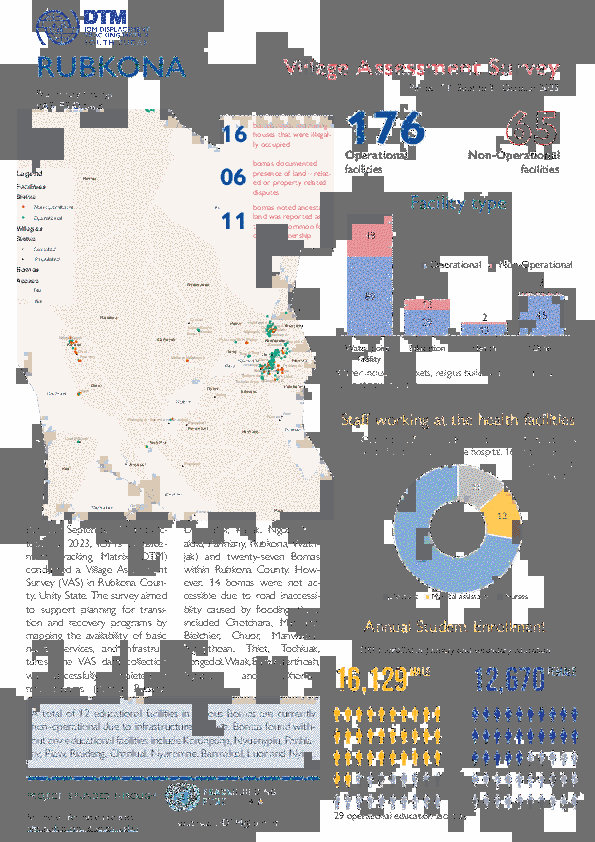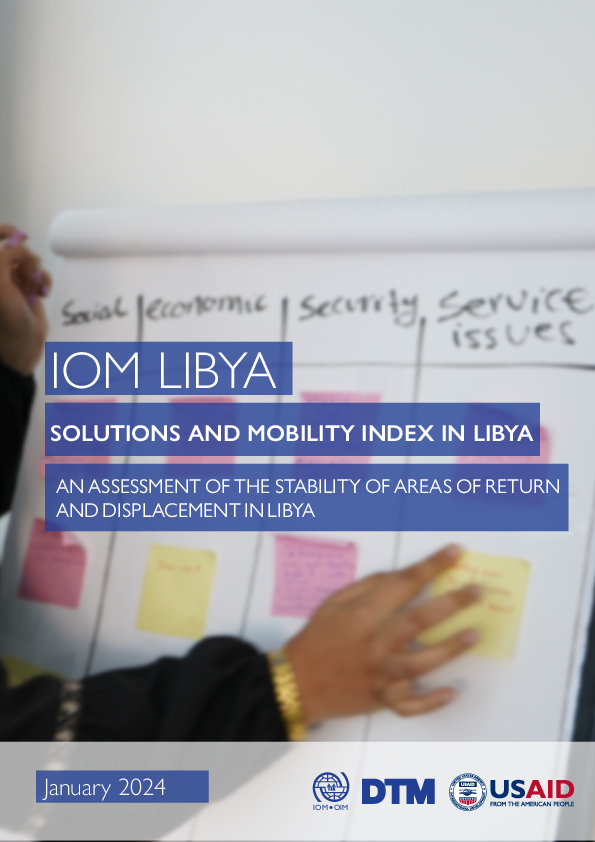-
Countries
-
Data and Analysis
-
Special Focus
-
Crisis Responses
Assessment Report

Contact
DTM Europe, DTMMediterranean@iom.int
Language
Bosnian, Croatian, Serbian
Location
Serbia
Period Covered
Feb 01 2024
Feb 29 2024
Activity
- Survey
- Flow Monitoring
This report, based on a multi-method and multi-source approach, provides insights into the profiles, experiences and journeys of migrants transiting through the Republic of Serbia.
Data was collected from 1 to 29 February 2024 together with the Commissariat for Refugees and Migrants of the Republic of Serbia (SCRM). IOM interviewed 365 migrants in 9 reception centers.

Contact
DTM Europe, DTMMediterranean@iom.int
Language
English
Location
Serbia
Period Covered
Feb 01 2024
Feb 29 2024
Activity
- Survey
- Flow Monitoring
This report, based on a multi-method and multi-source approach, provides insights into the profiles, experiences and journeys of migrants transiting through the Republic of Serbia.
Data was collected from 1 to 29 February 2024 together with the Commissariat for Refugees and Migrants of the Republic of Serbia (SCRM). IOM interviewed 365 migrants in 9 reception centers.

Contact
DTM Europe, DTMMediterranean@iom.int
Language
Bosnian, Croatian, Serbian
Location
Bosnia & Herzegovina
Period Covered
Feb 01 2024
Feb 29 2024
Activity
- Survey
- Flow Monitoring
This report, based on a multi-method and multi-source approach, provides insights into the profiles, experiences, needs, routes travelled and intentions of migrants transiting through Bosnia and Herzegovina.
Data was collected from 1 February to 29 February 2024. IOM carried out a route observation exercise to monitor trends in entries and exits as well as transit modalities within BiH. IOM also surveyed 792 migrants in active transit locations such as bus stops or at key entry and exit locations throughout the country as well as in 4 transit reception centres.

Contact
DTM Europe, DTMMediterranean@iom.int
Language
English
Location
Bosnia & Herzegovina
Period Covered
Feb 01 2024
Feb 29 2024
Activity
- Survey
- Flow Monitoring
This report, based on a multi-method and multi-source approach, provides insights into the profiles, experiences, needs, routes travelled and intentions of migrants transiting through Bosnia and Herzegovina.
Data was collected from 1 February to 29 February 2024. IOM carried out a route observation exercise to monitor trends in entries and exits as well as transit modalities within BiH. IOM also surveyed 792 migrants in active transit locations such as bus stops or at key entry and exit locations throughout the country as well as in 4 transit reception centres.

Contact
DTM South Sudan, SouthSudanDTM@iom.int
Language
English
Location
South Sudan
Period Covered
Sep 23 2023
Oct 19 2023
Activity
- Mobility Tracking
- Site Assessment
Between 23 September and 19 October 2023, IOM's Displacement Tracking Matrix (DTM) conducted a Village Assessment Survey (VAS) in Wau County, Western Bahr el Ghazal. The Survey aims to support planning for transition and recovery programs by mapping the availability of basic needs, services, and infrastructure. The VAS data collection was successfully completed in five payams (Bagari, Beselia, Kpaile, Wau North, and Wau South) and forty-two bomas within Wau County. However, three bomas including Hai Jadid, Gittan and Rafili wer not assessed due to either being deserted or poor road conditions.

Contact
DTM South Sudan, SouthSudanDTM@iom.int
Language
English
Location
South Sudan
Period Covered
Sep 14 2023
Oct 03 2023
Activity
- Mobility Tracking
- Site Assessment
- Village Assessment
Between 14 September and 3 October 2023, IOM's Displacement Tracking Matrix (DTM) conducted a Village Assessment Survey (VAS) in Rubkona County, Unity State. The survey aims to support planning for transition and recovery programs by mapping the availability of basic needs, services, and infrastructure. The VAS data collection was successfully completed in nine payams (Bentiu, Budang, Dhor Bor, Kaljak, Ngop, Nhialdiu, Panhiany, Rubkona, and Wathjak) and twenty-seven bomas within Rubkona County. However, 14 bomas were not accessible due to road inaccessibility caused by flooding, these included Chotchara, Mathiang, Bielchier, Chuor, Manwalbar, Ngopthoan, Thiet, Tochluak, Tongedol, Waak, Bany, Kuerthoah, Ngaplel, and Dhorbor

Contact
DTMUkraine@iom.int
Language
English
Location
Ukraine
Period Covered
Feb 01 2024
Feb 29 2024
Activity
- Baseline Assessment
The Registered IDP Area Baseline Assessment provides granular data on the number and geographic location of officially registered internally displaced people (IDPs). This report assesses registered IDP presence at the hromada level, also mapping the recorded change since the previous round.
The data collected for the Area Baseline Assessment Round 33 reflects the up-to-date local administrative register of the IDP population as of 29 February 2024, equivalent to a total of 3,413,472 registered IDPs. Registered IDP figures were collected for 1,098 hromadas (83% of all hromadas covered in Ukrainian government-controlled areas), across 108 raions and 23 oblasts. Data disaggregated by age, sex and disability status were provided for around 83 per cent of the administrative units covered.

Contact
DTM Libya, DTMLibya@iom.int
Language
English
Location
Libya
Period Covered
Jun 01 2023
Sep 30 2023
Activity
- Survey
In consideration of its Internal Displacement Strategy, IOM developed this Solutions and Mobility Index (SMI) Report to further support with data initiatives around fragility, solutions and mobility. This report provides an assessment of stability in municipalities, focusing on three key themes: livelihoods and access to basic services, social cohesion, and disaster risk reduction measures.
This report presents analysis on the Stability Index for all 100 municipalities in Libya, combining nine sub indicators to estimate a score for each municipality. These indicators are based on data collected through interviews with key informants conducted between June and September 2023 across 100 municipalities in Libya using both in-person and phone interviews. Multiple key informants from different communities were interviewed in each municipality, thus the results represent snapshots of community-level information as of mid-year 2023. The key informants included IDP and returnee leaders, community workers, civil society representatives, among others.

Contact
DTM Europe, DTMMediterranean@iom.int
Language
English
Location
Slovakia
Period Covered
Jan 01 2023
Dec 31 2023
Activity
- Survey
Key Findings:
- Among respondents, 75 per cent are active (employed or unemployed), and 25 per cent are inactive (student status, parental leave, retirement, unemployment and not looking for a job).
- Within active population, 63 per cent are employed and 37 per cent are unemployed.
- Employment rate is higher (70%) among those who speak Slovak fluently.
- Women with children experience lower employment rates: 55 per cent are employed with at least one infant (0-4 years-old) and 60 per cent are employed with at least one child (5-17 years-old).
- 62 per cent of women in single-headed households are employed.
- Top barriers to employment: language barrier (52%), family duties (24%), medical conditions (11%). (*more than one answer possible)
- Satisfaction with job and skills matching is higher among men (71%) than women (51%)
- Employment support is ranked among the top 5 needs*: 29 per cent of respondents are in need of employment support. (*more than one answer possible)

Contact
DTMUkraine@iom.int
Language
English
Location
Ukraine
Period Covered
Nov 27 2023
Dec 12 2023
Activity
- Survey
З 27 листопада по 27 грудня 2023 року Міжнародна організація з міграції (МОМ) провела 15-й раунд Опитування загального населення (GPS) - високорепрезентативної оцінки внутрішнього переміщення та повернення в Україні. П'ятдесят експертів зі збору даних провели скринінгові телефонні інтерв'ю з 20 000 випадково відібраних респондентів та подальші інтерв'ю з 1 517 ВПО, 1 541 особами, які повернулися, та 2 002 місцевими жителями, використовуючи методологію комп'ютеризованого телефонного інтерв'ю (CATI) та метод випадкового набору номера (RDD).
У цьому звіті представлені основні результати Раунду 15 GPS, зокрема детальна інформація про чисельність населення, переміщення та наміри щодо повернення, демографічні профілі, склад домогосподарств і вразливості, а також потреби населення, що повертається, з метою сприяння прийняттю обґрунтованих рішень щодо стратегічних, технічних і програмних аспектів реагування на надзвичайні ситуації та заходів з відновлення в Україні.
Pagination
- Previous page
- Page 43
- Next page
